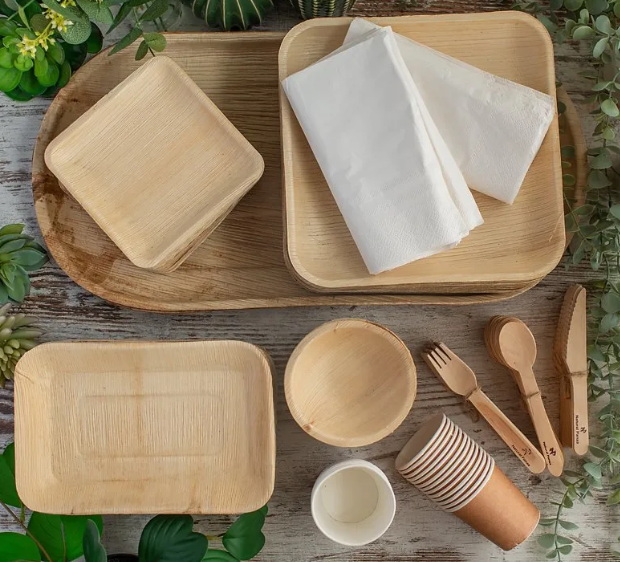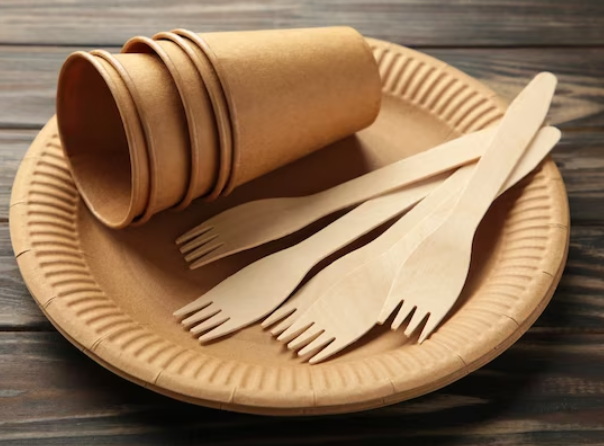
Content Menu
● Understanding Disposable Paper Tableware
● How Are Disposable Paper Plates Made?
● Common Coatings and Their Implications
● Can Disposable Paper Plates Handle Hot Food?
>> Heat Tolerance
>> Risks with Very Hot Foods and Liquids
● Chemical Exposure: What Should You Know?
>> PFAS and Other Chemicals
>> Migration of Chemicals
● Microwave and Oven Use: What's Safe?
>> Microwave Use
>> Oven Use
● Health and Safety Guidelines for Using Disposable Paper Tableware
● Environmental Considerations
● Alternatives to Disposable Paper Plates for Hot Food
● Proper Usage Tips for Disposable Paper Tableware
● Conclusion
● FAQ: Disposable Paper Tableware and Hot Food
>> 1. Can I use disposable paper plates for hot soup or boiling liquids?
>> 2. Are all disposable paper plates microwave-safe?
>> 3. What chemicals should I be concerned about in disposable paper tableware?
>> 4. Is it safe to use disposable paper plates in the oven?
>> 5. Are there safer or more eco-friendly alternatives to disposable paper plates for hot food?
Disposable paper tableware has become a staple in modern households, outdoor gatherings, and events due to its convenience and ease of use. Among these, disposable paper plates are especially popular for serving a wide range of foods, from snacks to full meals. However, a common question arises: are disposable paper plates safe for hot food? This article explores the safety, potential risks, and best practices associated with using disposable paper tableware for hot food, offering a comprehensive guide for health-conscious consumers.

Understanding Disposable Paper Tableware
Disposable paper tableware refers to single-use items made primarily from paper pulp. These include plates, bowls, cups, and trays designed for quick disposal after use. The main appeal of disposable paper tableware lies in its lightweight nature, affordability, and the fact that it minimizes the need for washing up. However, the safety of these products, especially when used with hot food, depends on several factors, including material composition, coatings, and intended use.
How Are Disposable Paper Plates Made?
Disposable paper plates are typically manufactured from wood pulp, bamboo, or sugarcane fibers. To enhance their durability and resistance to moisture and grease, many plates are coated with materials such as wax, plastic, or chemical compounds. These coatings prevent the plate from absorbing liquids and breaking down prematurely, but they also introduce potential safety considerations when exposed to heat.
Common Coatings and Their Implications
The most common coatings used in disposable paper tableware include:
- Wax coatings: Provide a moisture barrier but can melt at high temperatures.
- Plastic coatings: Often made from polyethylene or similar materials, these offer better resistance to liquids but can release chemicals when heated.
- Chemical treatments: Some plates are treated with per- and polyfluoroalkyl substances (PFAS) to enhance grease resistance. PFAS are persistent chemicals linked to health concerns if ingested over time.
Can Disposable Paper Plates Handle Hot Food?
Heat Tolerance
Disposable paper plates are generally designed to handle warm foods comfortably. For instance, serving freshly cooked pasta, grilled meats, or hot sandwiches is typically safe. However, the structural integrity of the plate may be compromised if the food is extremely hot, especially if it contains a lot of moisture or oil. In such cases, the plate may become soggy, lose its shape, or even leak.
Risks with Very Hot Foods and Liquids
While disposable paper plates can manage warm foods, they are less suitable for very hot foods or liquids. Hot soups, boiling stews, or foods straight from the oven can cause the plate to weaken, deform, or allow coatings to leach into the food. This risk increases with coated plates, as some coatings may melt or break down at high temperatures, potentially releasing harmful substances.
Chemical Exposure: What Should You Know?
PFAS and Other Chemicals
A significant concern with disposable paper tableware is the presence of chemicals like PFAS, BPA, and phthalates. These substances are often added to make plates more resistant to grease and water. While generally considered safe in small amounts, frequent use-especially with hot or acidic foods-may increase exposure and potential health risks.
Migration of Chemicals
When disposable paper plates are exposed to high temperatures, there is a possibility that chemicals from coatings or inks can migrate into the food. This is particularly true for plates with plastic or acrylic coatings, which may start to break down at elevated temperatures. For typical hot food, the risk is lower, but it is still advisable to avoid using such plates with extremely hot or oily foods.

Microwave and Oven Use: What's Safe?
Microwave Use
Many disposable paper plates are labeled as microwave-safe, meaning they can withstand the short bursts of heat typically used for reheating food. However, not all plates are created equal. Plates with plastic or wax coatings, or those with heavy inks, may not be suitable for microwave use, as these materials can melt or release fumes. Always check the packaging for microwave-safe labeling before reheating food on disposable paper tableware.
Oven Use
Disposable paper plates are generally not safe for use in conventional ovens. Most paper plates will ignite at high temperatures, posing a fire hazard. Even at lower temperatures, they may warp, discolor, or contaminate food. The only exception is sugarcane (bagasse) plates, which have a higher heat tolerance and may be suitable for short-term oven use.
Health and Safety Guidelines for Using Disposable Paper Tableware
To minimize health risks and ensure the safe use of disposable paper tableware with hot food, consider the following guidelines:
- Choose products labeled as food grade, microwave-safe, or safe and harmless.
- Avoid using disposable paper plates for foods that are extremely hot, oily, or acidic.
- Do not use paper plates in ovens or under broilers.
- Limit the use of coated plates with hot food, especially if the coating is plastic or wax-based.
- Opt for uncoated, compostable, or sugarcane-based plates for the safest experience.
- Dispose of used plates promptly and avoid reusing them to prevent bacterial growth.
Environmental Considerations
Disposable paper tableware is often marketed as an eco-friendly alternative to plastic. While paper plates decompose faster and are often made from renewable resources, their environmental impact depends on the coatings and additives used. Plates treated with PFAS or plastic coatings are not compostable and may contribute to environmental pollution. For the most sustainable choice, look for uncoated or certified compostable options.
Alternatives to Disposable Paper Plates for Hot Food
If you frequently serve hot food and are concerned about the safety or environmental impact of disposable paper tableware, consider these alternatives:
- Reusable plates: Made from ceramic, glass, or stainless steel, these are the safest and most sustainable option.
- Compostable plates: Made from materials like palm leaves or sugarcane bagasse, these are suitable for hot food and break down naturally.
- Heavy-duty paper plates: Multi-layered and sometimes reinforced, these can handle hotter foods but still have limitations compared to reusable options.
Proper Usage Tips for Disposable Paper Tableware
- Always check for manufacturer instructions regarding temperature limits.
- Avoid prolonged soaking of paper plates in hot liquids to prevent weakening and leaks.
- Use double plates for extra support when serving heavy or very hot foods.
- Store plates in a cool, dry place to maintain their structural integrity.
Conclusion
Disposable paper tableware offers undeniable convenience, especially for large gatherings, picnics, or busy lifestyles. When used correctly, disposable paper plates are generally safe for serving warm or moderately hot foods. However, caution is warranted with extremely hot, oily, or acidic foods, as well as with plates that have plastic or chemical coatings. To maximize safety, always choose food-grade, microwave-safe, or compostable options, and avoid exposing disposable paper plates to high temperatures or prolonged contact with hot liquids. For those seeking the safest and most eco-friendly solution, reusable or certified compostable tableware remains the gold standard.

FAQ: Disposable Paper Tableware and Hot Food
1. Can I use disposable paper plates for hot soup or boiling liquids?
No, disposable paper plates are not recommended for hot soup or boiling liquids. The heat and moisture can weaken the plate, causing it to become soggy or leak, and may also increase the risk of chemical migration from coatings.
2. Are all disposable paper plates microwave-safe?
Not all disposable paper plates are microwave-safe. Only plates specifically labeled as microwave-safe should be used in the microwave. Plates with plastic or wax coatings, or heavy inks, may melt or release fumes when heated.
3. What chemicals should I be concerned about in disposable paper tableware?
The main chemicals of concern are PFAS, BPA, and phthalates, which are sometimes used to make plates grease- or water-resistant. These chemicals are generally safe in small amounts but can pose risks with frequent use, especially with hot or acidic foods.
4. Is it safe to use disposable paper plates in the oven?
No, disposable paper plates should not be used in the oven. They are not designed to withstand high temperatures and can catch fire or release harmful substances. Only sugarcane (bagasse) plates may be suitable for short-term oven use, but always check manufacturer guidelines.
5. Are there safer or more eco-friendly alternatives to disposable paper plates for hot food?
Yes, alternatives include reusable plates made from ceramic, glass, or stainless steel, as well as compostable plates made from palm leaves or sugarcane bagasse. These options are safer for hot food and more environmentally friendly.

















